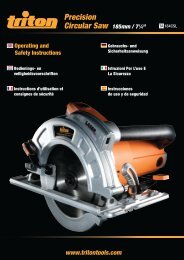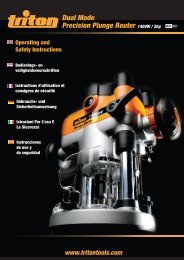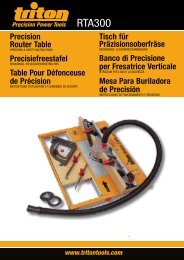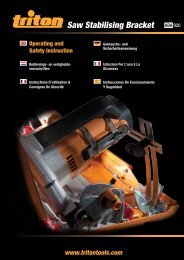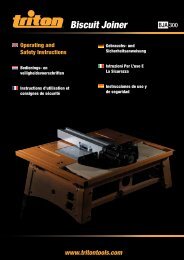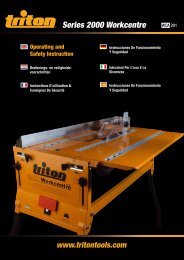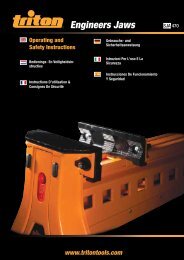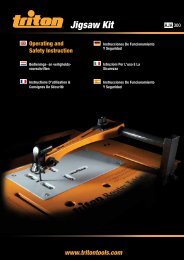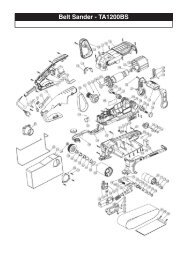Instruction Manual - Triton Tools
Instruction Manual - Triton Tools
Instruction Manual - Triton Tools
Create successful ePaper yourself
Turn your PDF publications into a flip-book with our unique Google optimized e-Paper software.
GB<br />
Check the sliding table throughout its travel for<br />
diagonal rocking on the tracks, and fine tune the<br />
height of the outer track if necessary. Adjust the<br />
height stops on the outer track legs to lock-in the<br />
correct height.<br />
Next it will be necessary to fine-tune the height of<br />
the inner track. With a Router Table fitted, locate<br />
the fence onto the sliding table and extend it across<br />
the Router Table. The fence should sit around 1 ⁄32"<br />
above the Router Table. Slide the table to the rear of<br />
the Stand and check it is level throughout the range.<br />
If necessary remove the inner track from the track<br />
clamps and relocate the shims, combining them or<br />
removing them entirely if required, at the front and/<br />
or rear. Loosely re-fit the bolts and nuts.<br />
STEP 14R<br />
With the sliding table positioned midway along the<br />
tracks, engage the front and rear locking latches<br />
(Fig. 10). Adjust the Phillips screws until the heads<br />
enter the slots and the table cannot be lifted. (You<br />
will need to release the latches and lift the table to<br />
make these adjustments).<br />
STEP 15R<br />
The last step is to fine-tune the inner track position<br />
in the horizontal plane. While this is not a critical<br />
alignment for routing, it is recommended.<br />
The inner track can be aligned for the scales to read<br />
accurately only when used with the Router Table<br />
model RTA300. Fit a 1 ⁄2" straight cutter into your<br />
router and find a parallel sided board, say 16" wide.<br />
In the 'Table Locked' mode, lock the rip fence at<br />
the exact board width (A). (Fig. 12). Place the board<br />
between the fence and the tip of the cutter then<br />
adjust the position of the inner track, (Fig. 11), until<br />
the board fits exactly between the fence and the<br />
blade and is parallel to the right hand edge of the<br />
router table, as shown. Tighten the Nyloc nuts.<br />
For early model router and jigsaw tables lock the<br />
rip fence parallel in the 'Table Locked' mode, and<br />
measure from the face of the fence to the right hand<br />
edge of the Router Table (B). (Fig. 12). Adjust the<br />
inner track, (Fig. 11), until the fence is parallel to the<br />
edge of the table. Tighten the Nyloc nuts.<br />
Your Sliding Extension Table is now fully assembled<br />
and ready for use. Skip to the 'Use with a Router<br />
Table' section.<br />
USE WITH A WORKCENTRE OR COMPACT<br />
- TABLE LOCKED<br />
Lock the table using the front and rear locking<br />
latches and fit the rip fence. Set your width by<br />
sighting the scales down the front face of the fence.<br />
Ensure the fence is always set parallel to the blade<br />
(ie. locked at the same scale reading front and rear).<br />
(Fig. 13).<br />
Make sure that the overhead guard is lowered<br />
onto the workpiece. Guide the sheet against the<br />
fence at all times. When working with long sheets<br />
the plastic skids at the ends of the inner track will<br />
provide additional support. However when handling<br />
very wide workpieces we recommend the <strong>Triton</strong><br />
Multi-Stands (Fig. 14) or have someone assist<br />
you to support the workpiece. When ripping thin<br />
workpieces you may need to fit an edge support (as<br />
shown in the inset on Fig. 14) against the rip fence,<br />
to prevent the corner of the workpiece from dipping<br />
into the table openings.<br />
MK3 Workcentres: to rip in the 10" - 15" range,<br />
clamp a 4' long x 8" wide packer to the extension<br />
table fence. When setting the required width,<br />
remember to add 8".<br />
TABLE SLIDING<br />
Always slide the extension table the full length of<br />
the tracks before making your cut. Check that the<br />
rip fence clears the blade, and does not hit or 'ride<br />
up' on the table. Check that the sliding table does<br />
not rock on its tracks. Adjust the outer track height<br />
if necessary.<br />
Crosscutting<br />
Position the rip fence as shown in (Fig. 15). When<br />
tightening the clamps, ensure that the fence is<br />
pulled fully toward the outer edge of the table, for<br />
absolute squareness.<br />
For gauging lengths in the range 14 3 ⁄4" - 41", you<br />
can align the end of the workpiece with the required<br />
scale reading. For longer pieces, touch the fence<br />
tip against the saw blade teeth and use this to align<br />
a cutting mark on the workpiece. Note: if you wish<br />
to prevent the gradual cutting away of the fence<br />
tips (which were designed for this purpose) attach<br />
a small wooden fence tip using the screw holes<br />
provided.<br />
12<br />
Assembly



